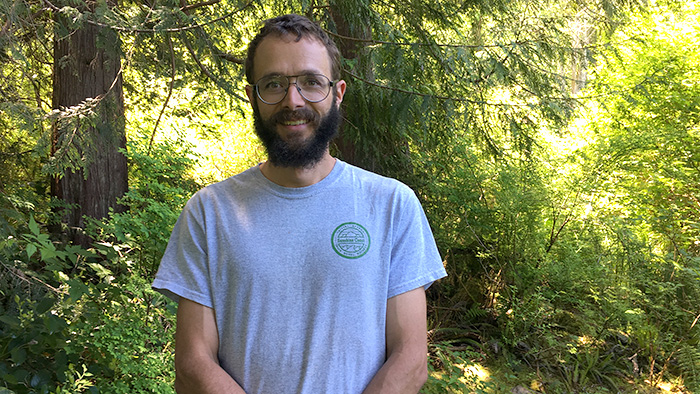Fighting a raging wildfire in Sechelt a couple of summers ago, Marc Albert was shocked by what he saw. Normally in a coastal forest fire, the flames lick along the ground, burning dry, dead branches, and bypassing the towering trees. Shade from the canopy usually keeps things cool and fires relatively small. Not this time.
Instead, this intense fire burnt thick logs on the ground, and roared up the bark of mature Douglas-firs, setting the forest’s canopy alight and consuming entire trees. The scene left the Stillwater resident with a sense of awe. And also disappointment: this fire was likely caused by human negligence.
“The climate is changing, and we have to adapt to that,” said Marc, Powell River’s new FireSmart coordinator. “We’re going to need to change our behaviours and the way we build communities and how we do things. Who knows; in 15 years, our climate may look much more like California’s, and we’ll see these bigger fires on a regular basis.”
Marc has served on the local wildfire crew for eight years, but says even that’s too short a time to definitively measure environmental change in the woods. Things are increasingly unpredictable – drier dries, wetter wets, stronger winds – and anomalies are the new normal. So, he’s keeping his job as wildfire crew leader, but as of May, he’s also taking on a public education role, too: helping locals understand how to protect their properties as fires likely become more frequent and more intense here.
FireSmart is a national program that is being instituted in Powell River this summer, by the Regional District, the City and Tla’amin. Like Let’s Talk Trash and Bear Aware, FireSmart aims to help locals adapt to change through knowledge and friendly engagement.
Remember the yellow smoke that hung over Powell River for three days in 2015, as communities from Pemberton to Gibsons wondered if they’d see flames? Wildfires can make people feel powerless.
However, locals can, in fact, do a lot to protect their homes during fire season, according to Ryan Thoms, Regional District’s Manager of Emergency Services.
For example, just after wildfires swept through Fort MacMurray last May, one researcher stepped into the ashes to find out why some homes survived and others did not. In a report shared by Ryan, the Institute for Catastrophic Loss Reduction found that in general, homes that had applied FireSmart principals to their properties (see sidebar) survived, while those that did not, did not.
“We imagine that in a fire, walls of flames run over things,” said Ryan. “It wasn’t so in Fort Mac. There, small embers falling and catching on porches or in yards – and catching – is how the vast majority of homes burned. That’s where FireSmart principals come in. Firefighters focus on the flame front – they can’t do much about flying embers. When they land, they either go out, or they find something they like.”
Ryan pointed out that every property is different, due to the surrounding trees and grass, building materials, whether it’s on a slope, and more.
“Once you understand what you’re looking at, sometimes solutions are very simple and no-cost,” Ryan said.
Watch for Marc around town this summer, and visit www.firesmartcanada.ca.
How FireSmart are you?
On June 17 and 18, the Powell River Regional District is hosting a training event for “Neighbourhood Champions,” those who would like to help introduce FireSmart principals to those where you live. Want to get involved? Contact Marc Albert at firesmartpr@gmail.com, and watch for more info at www.powellriverrd.bc.ca.
In the meantime, FireSmart Canada recommends that property owners:
• Complete a site assessment and area assessment around your property to list possible fire dangers (see www.firesmartcanada.ca for instructions)
• Use fire resistant materials when building or renovating your home’s roof or siding.
• Store firewood at least 10 metres away from buildings.
For more, see the Web site – and attend the FireSmart Coordinator’s mid-summer safety event!







